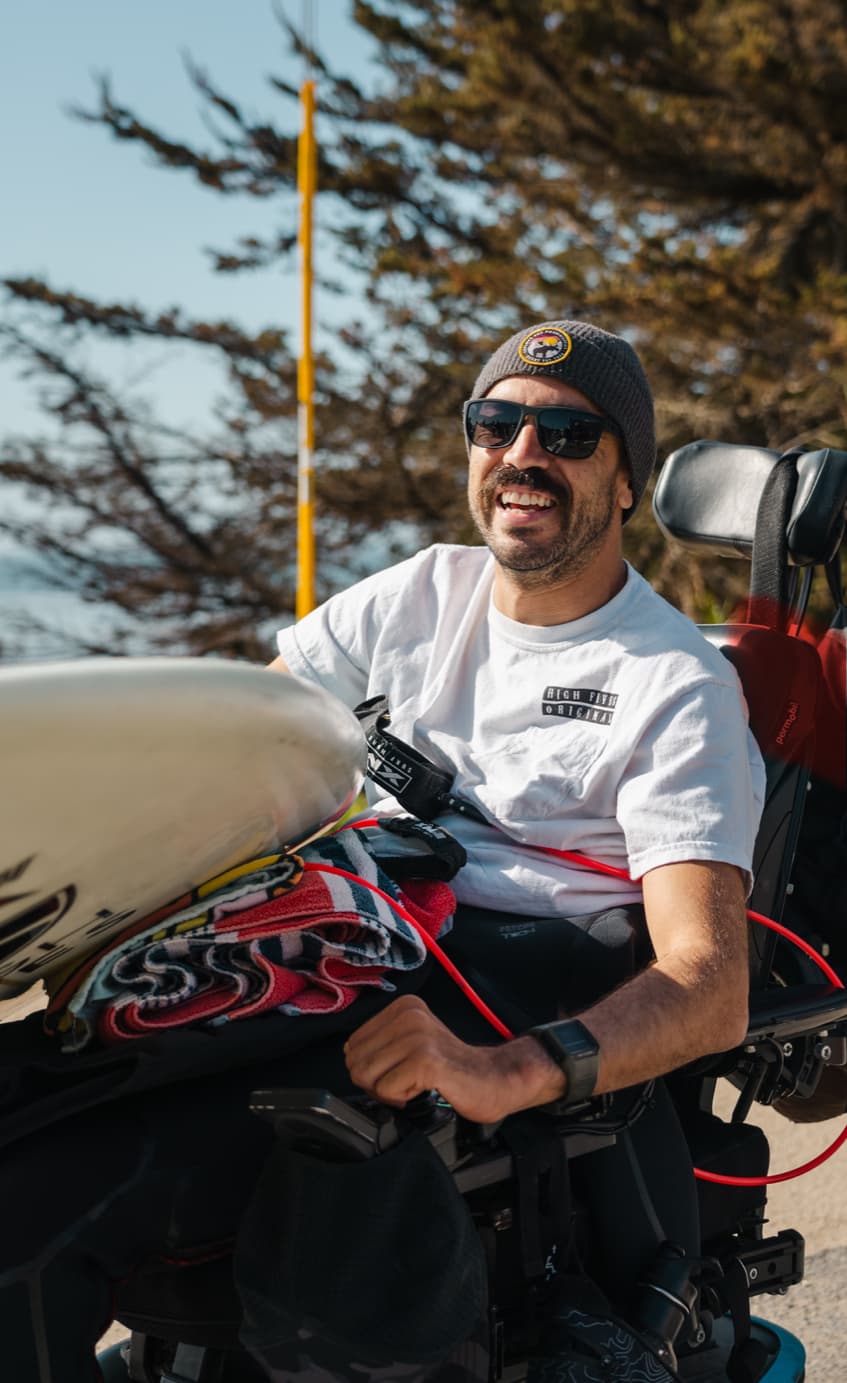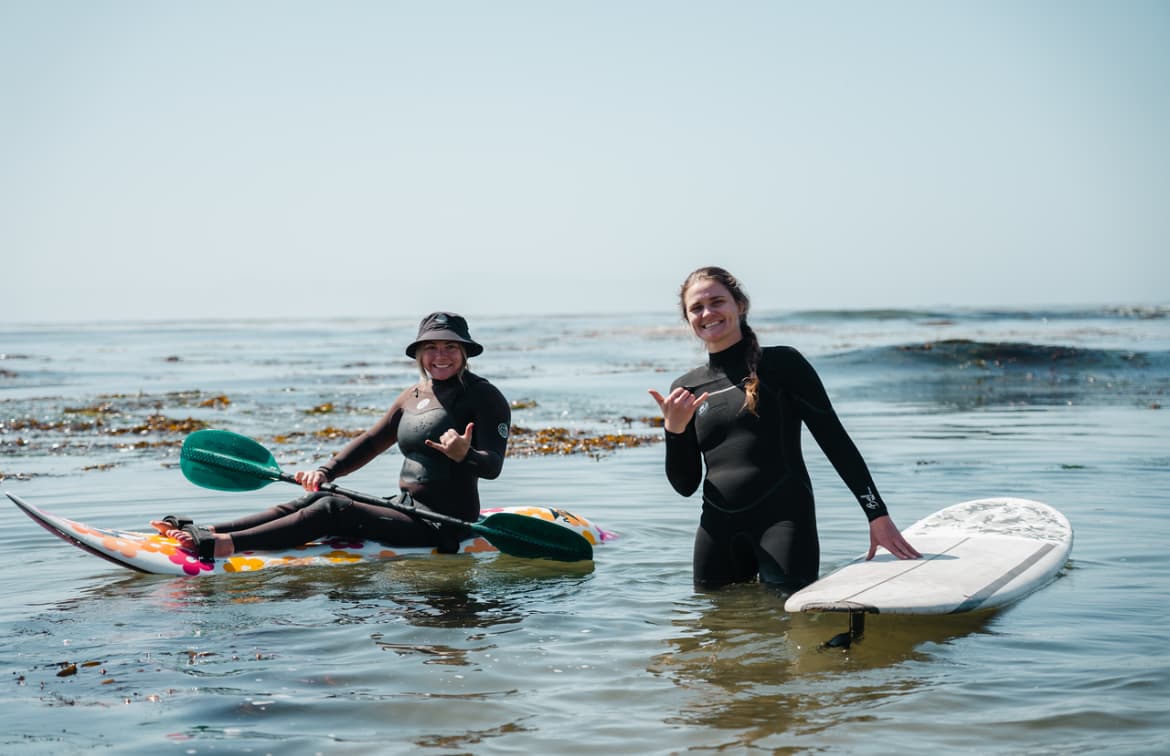Last Thursday, I had the pleasure of checking out the High Fives Foundation’s heartwarming surf camp held down at Pleasure Point, which brought adaptive surfers together for two days of wave riding, camaraderie, and positive vibrations. I was informed of the camp two days prior by my good friend Claudio Morales Bettini, an inspiring individual who, thirteen years ago, was involved in a serious accident that left him unable to walk. We met exactly one year after his life-changing injury, where I was fortunate enough to help him catch his first wave prior to his accident.
High Fives Foundation
Adaptive surfers find freedom and friendship amongst the healing waters of Pleasure Point


The joy and courage he radiated on that Spring day at 38th avenue was nothing short of magic, and that day remains one of the most pure and fulfilling experiences of my life. Since then, we’ve remained close friends, so I was eager to come check out his event at the very same break he reclaimed his love for surfing.
When I got down there in the morning, a lingering south swell was offering up perfectly playful 2-3 foot surf. The energy was high and a crew of dedicated volunteers such as Rob Jarvis and Jack Akrop were on hand to facilitate this very special day to ensure that participants had the time of their lives. As the participants trickled in, Claudio introduced me to High Fives founder and CEO Roy Tuscany, who, after suffering his own devastating skiing injury almost twenty years ago, made it his life’s work to inspire others to reclaim their lives through participation in outdoor sport, namely surfing, skiing, fishing, mountain-biking, and dirt-biking.
In hearing his story, I was extremely impressed by Tuscany’s resolve and dedication to facilitating these various camps. The hope and agency he’s providing these wounded warriors is nothing short of legendary. After the camp, I was lucky enough to ask him a few questions about his mission. Jarvis and Bettini were on hand to chime in with their perspective, and the resulting conversation was deep and moving.

Roy, can you introduce yourself and tell me how High Fives started?
Roy Tuscany– Yeah, my name’s Roy Tuscany, I’m founder and CEO of the High Fives Foundation. Back in 2006 I was an aspiring pro skier—I ended up going 130 feet on a 100 foot ski jump and burst fracturing my T-12 vertebrae, causing partial paralysis from the belly-button down. The biggest thing that I found was that healing best happens when you’re around community, when you’re around others. So I created a foundation to help an individual through the recovery process.
And now, 16 years later nearly a 1,000 people have been served by the foundation and we really focus on 5 different verticals of sport-because we have found that community is a by-product of sport. When people participate in sport you develop community naturally and that was the idea of all the different sports we focus on.

And why are we down here in Santa Cruz? Well, one of the sports we focus on is surfing. And the power of the ocean, the healing of the water, the ability to be out in a lineup with your friends without and type of adaptive devices around you really is empowering. So we’re down here hosting this camp for individuals who’ve sustained these life changing injuries and utilizing the local community of Santa Cruz, the incredible healing power of the ocean, and the amazingness that is the sport of surfing, to heal them further.

For these individuals, being bound to a wheelchair must feel restrictive at times. Can you comment on how the freedom of the surfing experience their outlook and mood?
Tuscany- Yeah, when people ask me, “Where’s that calm point for you?” What I’ve found for a calm point is when I’ve gotten off my board, in the ocean outside of the break, and you’re just like floating. There’s no other real place that you can do that. In a lake, the water’s not really moving that much beneath you. In a river, it is moving, but that makes it hard to stay in one spot. But outside the break in that ocean, you still feel the ocean churning and moving—you’re just allowed to be suspended right there.
When you really think about how you can get calm, you need to be in the moment like that. That’s what I always find. People always go, “Well, how many great waves did you catch?” And yeah, getting waves is a really cool thing, but how calm did you get? I think that’s the big take away surfing for me, is how much did you get to calm yourself? That to me is the really cool part.

What was the general vibe like at the High Fives Santa Cruz camp this year?
Claudio Morales-Bettini- Dude, ok, so the best thing about this competition is the camaraderie, vibe, and mutual stoke. Being in a wheelchair is not easy at all; it’s pretty rough! It’s a constant, daily uphill battle and so to find such a rad group of people with so much positivity and a desire to try things that most people in a wheelchair don’t think about is so rad. High fives all around (laughs). It’s really hard to put into words. The best part is seeing everyone so positive and stoked after all their waves. The guys who were surfing for the first time…seeing them riding waves and seeing how happy they were was priceless.
Rob Jarvis- The camp was a huge success. We had perfect weather, perfect waves, and perfect people involved. We had about a dozen adaptive athletes, some already surfers, and some new to the sport hooting and hollering and enjoying party waves. During the post surf dinner time chats about everybody’s waves, I just sat back and take it all in. When asked about a favorite moment, each one seemed to pick a colleague’s wave as a highlight. The way the crew came together on day one, you would’ve thought we were all lifelong friends. My top moments, and there were many, were watching Jimi and Jordan catch their very first waves, watching Roy and his partner Alana high five on a party wave, and seeing Alana and her son Gunnar ride a wave together.

How do camps such as this instill hope in those who participate?
Tuscany-A lot of the times after an individual has one of these life changing injuries, the idea of being an athlete, the idea of participating in a sport doesn’t feel possible. However, with a small adaptation, or meeting a group of individuals who don’t see no as an answer, they start to see no as a first negotiation to a yes. I think that’s something that gives the opportunity to not only, you know, participate in sport, but to do so in a way that feels like you’re enjoying the sport. It doesn’t feel like it’s a once in a lifetime moment, it’s something that can be repeated and shared, part of your joy.
Morales-Bettini- It’s just so cool to see how the High Fives supports the expression of the possibility to live a life that we never dreamed could happen when we first got injured; the hope that we can still live the dream. I wake up grateful everyday because of the experiences, the people, and the all the other ways that High Fives has supported me in living my best life, despite my injuries.
Jarvis- What the High Fives Foundation does to inspire the adaptive community is nothing short of amazing. I have watched this organization grow from a few athletes to almost 900 today, and that number is only growing. They are an amazing support network that spans the globe! That solidarity really important for these individuals.

What are the most powerful changes have you seen in participants of the camps throughout the years?
Tuscany-I think a lot of people, at first, are scared of the ocean. There’s a lot of unknown out there! I think now that more and more people have participated in adaptive surfing, and in many different ways, from prone, to sitting, to these modified stands using your arms as a secondary leg and stuff like that, I think it’s really given the idea of, “OK, this is what my body is capable of, and I think I could surf in this position.” That, and having examples of others showcasing what’s possible, it helps people get over that fear of getting in the ocean. I’ve seen the sport grow and seen people understand how adaptable it truly is. I think one of the big things is that, once people are in the ocean, they’re surfers, it’s not, we’re adaptive surfers, they’re surfers, and you get to call them that. It really empowers and gives them identity.
For more information about the High Fives Foundation, visit their website! www.highfivesfoundation.org
